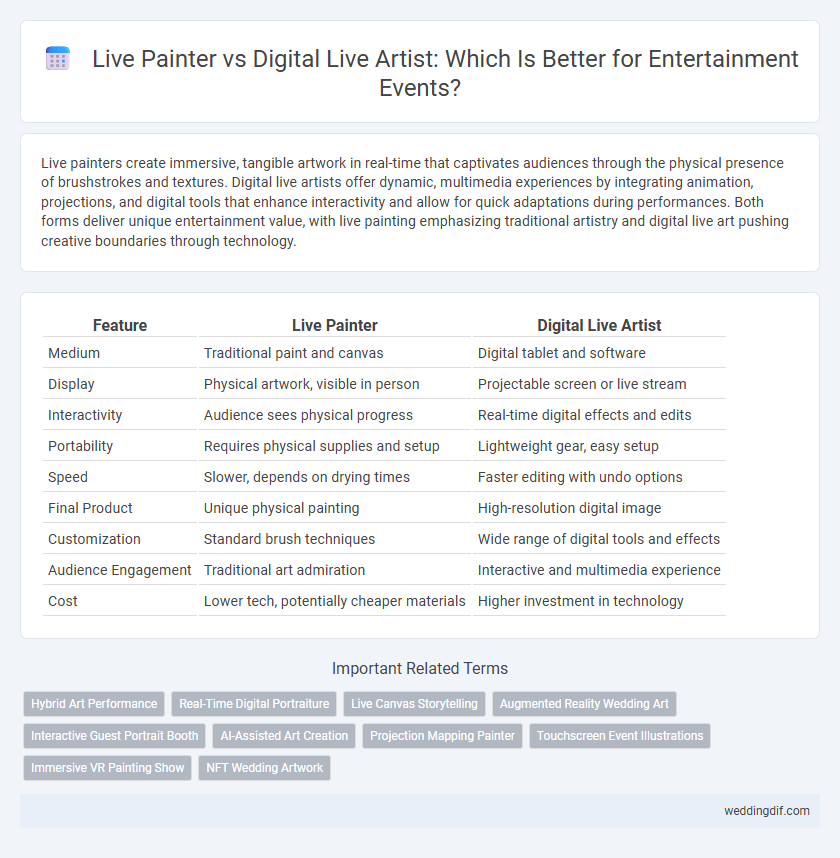Live painters create immersive, tangible artwork in real-time that captivates audiences through the physical presence of brushstrokes and textures. Digital live artists offer dynamic, multimedia experiences by integrating animation, projections, and digital tools that enhance interactivity and allow for quick adaptations during performances. Both forms deliver unique entertainment value, with live painting emphasizing traditional artistry and digital live art pushing creative boundaries through technology.
Table of Comparison
| Feature | Live Painter | Digital Live Artist |
|---|---|---|
| Medium | Traditional paint and canvas | Digital tablet and software |
| Display | Physical artwork, visible in person | Projectable screen or live stream |
| Interactivity | Audience sees physical progress | Real-time digital effects and edits |
| Portability | Requires physical supplies and setup | Lightweight gear, easy setup |
| Speed | Slower, depends on drying times | Faster editing with undo options |
| Final Product | Unique physical painting | High-resolution digital image |
| Customization | Standard brush techniques | Wide range of digital tools and effects |
| Audience Engagement | Traditional art admiration | Interactive and multimedia experience |
| Cost | Lower tech, potentially cheaper materials | Higher investment in technology |
Introduction to Live Wedding Entertainment
Live painter entertainment creates a unique and tangible keepsake by capturing wedding moments on canvas in real-time, offering guests a dynamic and engaging experience. Digital live artists use tablets and projection screens to illustrate scenes instantly, enabling interactive elements and faster versatility during ceremonies. Both methods elevate wedding entertainment through creativity, but live painting emphasizes classic artistry while digital art highlights technological innovation.
What is a Live Painter?
A live painter creates artwork in real-time during events, capturing the atmosphere and emotions on canvas with traditional painting tools like brushes and acrylics. This form of entertainment offers a tangible and evolving visual experience, as audiences witness the artwork's progression from blank canvas to finished piece. Live painting emphasizes physical presence, texture, and spontaneity, making it a dynamic addition to weddings, concerts, and corporate functions.
What is a Digital Live Artist?
A Digital Live Artist creates real-time visual art using digital tools such as tablets, styluses, and software like Procreate or Adobe Photoshop, often projected onto large screens to engage audiences during live performances or events. This form of entertainment blends technology with creativity, allowing for dynamic, interactive showcases that can be instantly shared on social media or streaming platforms. Unlike traditional live painters, Digital Live Artists offer versatility in effects, undo options, and seamless integration with multimedia elements, enhancing the overall audience experience.
Visual Impact: Canvas vs. Digital Display
Live painters captivate audiences with tangible, evolving artworks on canvas, creating a sensory connection through texture and physical presence. Digital live artists leverage vibrant screens and projection technology to deliver dynamic visuals with seamless transitions and interactive elements. The choice between canvas and digital display shapes the audience's immersive experience and the overall visual impact of live artistic performances.
Guest Engagement and Interaction
Live painters create unique, dynamic artworks in real-time, captivating guests through the tactile excitement of watching brushstrokes emerge on canvas. Digital live artists enhance interaction by incorporating multimedia elements, allowing guests to influence designs instantly via touchscreens or apps, fostering active participation. Both art forms elevate guest engagement by transforming entertainment into immersive, personalized experiences that resonate beyond the event.
Customization and Artistic Style
Live painters offer unique, handcrafted artwork with spontaneous brushstrokes that capture the event's energy, allowing for personalized customization in texture and medium. Digital live artists provide versatile customization options through layering, color adjustments, and real-time editing that enable diverse artistic styles from hyper-realistic to abstract. Both entertainment forms engage audiences differently, with traditional live painting delivering tactile authenticity and digital artistry offering dynamic, easily shareable creations.
Speed and Flexibility of Creation
Live painters create artwork in real-time using traditional media, offering a tangible, spontaneous experience that captures the energy of a performance with rapid brushwork and immediate physical presence. Digital live artists leverage advanced software and tools, enabling faster edits, easy corrections, and diverse stylistic changes on the fly, which provides unparalleled flexibility in adapting to the entertainment event's dynamic atmosphere. The speed of digital creation often surpasses traditional methods, allowing for seamless integration with multimedia elements and instant sharing across digital platforms.
Keepsakes: Physical Art vs. Digital Files
Live painters create tangible keepsakes that audiences can hold, display, and cherish for years, offering a unique, soulful connection through physical brushstrokes and textures. Digital live artists produce editable digital files that allow for easy sharing, duplication, and integration into multimedia projects, catering to modern, tech-savvy entertainment consumers. The choice between physical art and digital files hinges on the desired longevity, emotional impact, and versatility of the keepsake in entertainment settings.
Technical Requirements and Setup
Live painters require traditional art supplies such as canvases, brushes, and paints, alongside a well-lit stage area and protective coverings to manage mess and ensure visibility. Digital live artists depend on tablets or graphic tablets, laptops with specialized software like Adobe Photoshop or Procreate, high-resolution monitors, and a stable internet connection for real-time streaming. Both setups benefit from high-quality audio equipment and projection systems to engage the audience effectively.
Cost Comparison and Value for Weddings
Live painters typically charge between $1,500 and $3,500 for wedding events, reflecting the time-intensive nature of creating a single, unique piece. Digital live artists often offer more affordable packages, ranging from $500 to $1,500, providing faster delivery and versatile digital files for sharing. While live paintings serve as tangible keepsakes with artistic depth, digital art offers cost-effective creativity and instant access, allowing couples to choose based on budget and desired lasting value.
Live Painter vs Digital Live Artist for entertainment. Infographic

 weddingdif.com
weddingdif.com